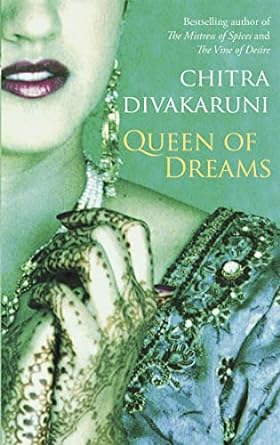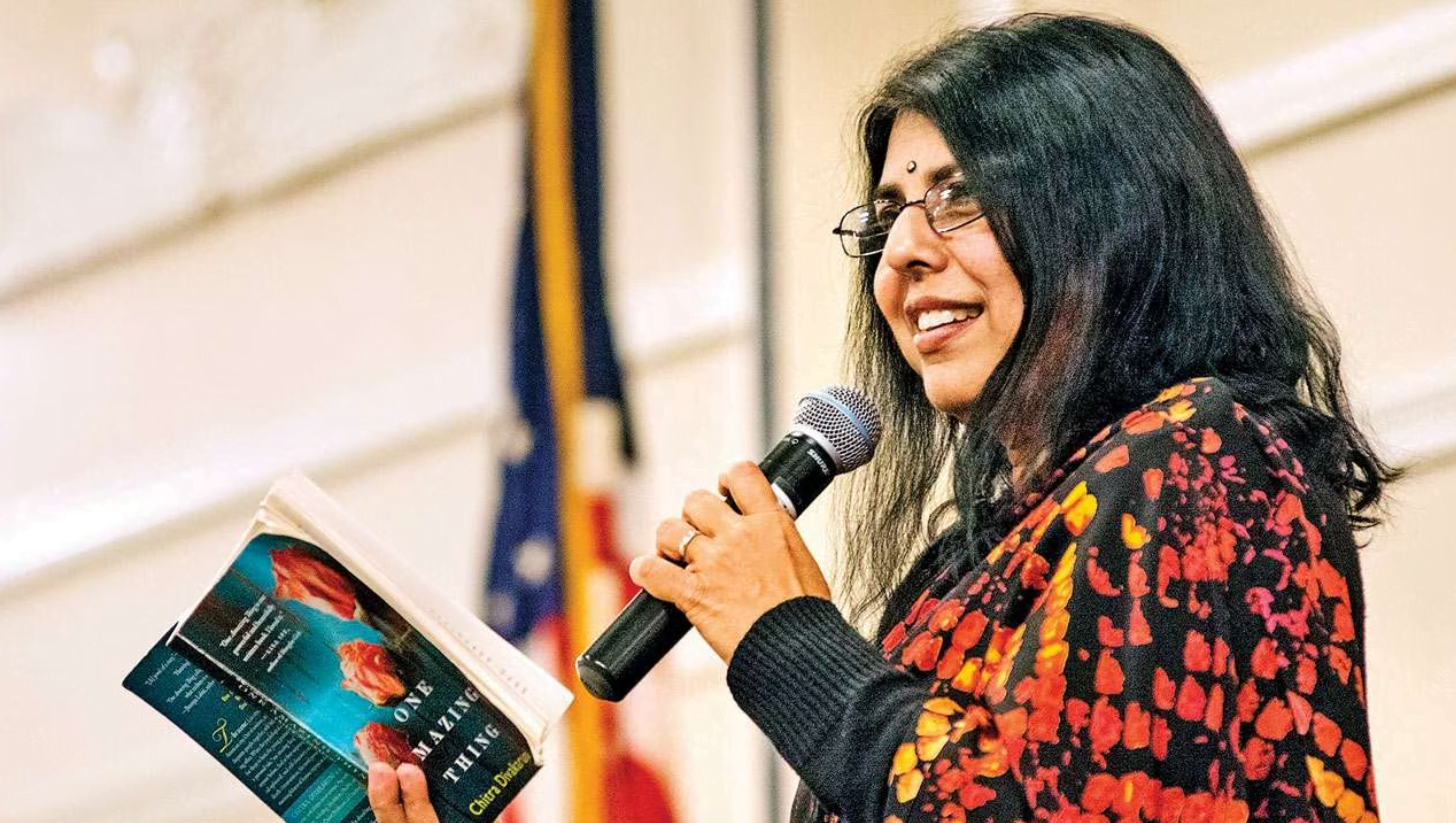Divakaruni’s work has provoked intense debate in anthologies where it has been featured. Chitra Banerjee Divakaruni is often associated with other contemporary Asian-American writers who have emigrated from India and write in English. Her works are often analysed from a global perspective and are said to attract the interest of Western readers.
Divakaruni’s writing covers a variety of themes, such as exoticism, women’s empowerment, cultural integration, and individuality.
Divakaruni’s Queen of Dreams
Divakaruni depicts the challenge faced by Indian Americans in preserving two identities or cultures in her 2004 book Queen of Dreams. She aims to close the distance between her mother, an immigrant from India, and her daughter, who was born in the United States. Mrs. Gupta, a first-generation Indian immigrant to the United States, is the dream queen.

She says, “A dream is a message from the unseen world.” She still carries a significant portion of her Indian heritage. It was not something she wanted to do. But society believed that she needed a man to survive. She married Mr. Gupta as a result. Instead of having a traditional wedding, she got legally married to him. She denies herself physical pleasure to make room for her dreams to invade.
Unlike her Indian classmates, Rakhi (Mrs. Gupta’s daughter) rejected Westernised clothes and read books about India during her school years. Ever since she was young, she had yearned for India. She considers the United States to be her home, having been born and raised there. She debates constantly about her made-up past and fantasises about visiting the enigmatic country of India—a trip she will never take. She alternates between the two civilisations constantly. Rakhi experiences an identity crisis and a sense of loss as a result of this. Rakhi’s mother, however, feels that keeping her daughter unaware of their Indian ancestry will help her from feeling torn between two identities and cultures.
“I didn’t want to be like those mothers, dividing you between your life as it is and what may never be,” the woman declares. But I turned India into something much more than it was by not telling you about it as it was. It took your attention away from other things. It exerted pressure on your mind akin to a tumour.
Following the terrorist attacks of September 11, 2001, native-born Americans started mistreating and demonising immigrants whose only transgression was that they were different-skinned or had darker skin than they did. But Rakhi doesn’t think it’s appropriate to flaunt her nationalism with flags or banners. She holds the opinion that “I am an American citizen without having to fly a flag! I already live in America. I am aware that I adore this nation.”
She tries to make sense of her chaotic life of hyphenated identities—as a failing businesswoman, a failing mother, a divorced mother, and a daughter obsessed with her mother—by visualising her identity in a particular way; however, she ends up in an incomprehensible situation. Rakhi wonders, “But if I was not American, then what was I?” as she starts to doubt who she is. Her appearance seems foreign to her, and she feels uprooted. There is no longer any intrinsic feeling of being an American. Rakhi is shocked. “She feels the urge to pray, but she is not sure which deity, American or Indian, she should pray to.”
Even though she is in America, Mrs. Gupta is still Indian. Mrs. Gupta rejects all of the important roles in her life, including being a fantastic wife and mother, to preserve her identity as a dream interpretation for the duration of her life. Rakhi is a second-generation immigrant, so her adjustment to American culture starts in childhood, but it will take a lot of work for her to fully integrate and assimilate. Before the World Trade Center tragedy, she had never felt alienated. Rakhi rejects the idea of a single, fixed identity, instead developing a sense of many, multiple identities. She acknowledges her dual identity as an American and Indian citizen.
The Forest of Enchantments: The power of the divine feminine
Chitra Banerjee Divakaruni’s “The Forest of Enchantments” is a story told from Sita’s point of view and is referred to as “Sitayan.” Sitayan is not just about Sita, but also about the other marginalised female characters from the Ramayana. The book describes Sita’s struggles and how she learned to cope with them. While most versions of the Ramayana focus on extolling Ram, they fail to acknowledge the horrors Sita endured.

Chitra Banerjee Divakaruni portrays Sita as a regular woman with her hopes and desires, rather than as a goddess. Unlike other adaptations of the Ramayana, this book is exceptionally beautiful and treats each character with fairness and respect.
The novel explores the various roles Sita played in her life, from daughter to wife to warrior and mother, while also highlighting her humanity. Despite facing significant challenges and betrayals, Sita maintained her strength and resilience. Ultimately, she chose to stand up for herself and challenge societal expectations, giving voice to misunderstood women characters in her story. The novel not only retells the Ramayana but also promotes timeless values relevant to today’s world.
Cultural feminism emerged from radical feminism in the 1970s and recognises the differences between men and women, valuing feminine qualities that have been historically undervalued. Cultural feminists believe that women’s approach to the world, characterised by nurturing, cooperation, and emotional intelligence, is superior to traditional masculine traits like aggression and dominance. They advocate for the empowerment of women through forming bonds with other women and celebrating female culture. Central figures in cultural feminism include Mary Daly, Jane Addams, and Adrienne Rich.
The novel portrays Sita as a strong-willed and outspoken woman who trusts her instincts. Through a cultural feminist lens, it becomes apparent that Sita’s life would have been different if her husband, Ram, had believed and listened to her. Despite the patriarchal society she lived in, Sita managed to find solutions to problems without disrespecting anyone. She believed in addressing wrongdoing in a way that didn’t hurt a man’s pride, following her mother’s advice. Sita approached problems peacefully to promote positivity.
The incident involving Ravan’s sister, Surpanaka, had a profound impact on everyone involved. If Ram and Lakshman had handled the situation differently, their lives would have turned out differently. Sita, as a woman, empathised with Surpanaka and believed she deserved respect rather than humiliation. Sita wished she had the chance to treat Surpanaka with kindness, which may have prevented a war. The way Ram and Lakshman handled the situation changed their lives forever. This highlights the idea that women can often approach situations more logically, but are not always allowed to do so. In the novel “The Liberation of Sita” by Volga, Surpanaka is portrayed as a character who has achieved self-realisation, and her words resonate with Sita.
Throughout history, women have been burdened with the responsibility of handling both physical and societal challenges, while men in positions of power often dismiss their struggles. Sita, a victim of this patriarchal system, was unfairly doubted and left behind by her husband, Ram. Despite facing mistreatment, Sita eventually asserted herself and advocated for the empowerment of women, highlighting the significance of self-respect over resentment and self-pity. The tragedy could have been prevented if Ram had publicly supported Sita, but ultimately Sita’s actions were justified.
The lives of female characters connected to Sita would have been different if her voice had been respected. Cultural feminism aims to restore a balance between men and women while prioritising women. John Milton believed that books are valuable and Sita wrote Sitayan to share her perspective and highlight overlooked female characters. She hoped to inspire courage, understanding, and self-respect in women through her writing.
Chitra Banerjee Divakaruni is highly knowledgeable about every event that takes place in India, including the ability to comprehend and stay aware of others’ expectations. She adapts herself to meet these expectations. Divakaruni skillfully explores the mindset of Indian women, who, to lead a peaceful life, do not resist or question anything and simply accept whatever happens, even if it results in losing their sense of self.






